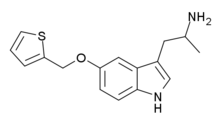BW-723C86
BW-723C86 is a tryptamine derivative drug which acts as a 5-HT2B receptor agonist. It has anxiolytic effects in animal studies,[1][2] and is also used for investigating the function of the 5-HT2B receptor in a range of other tissues.[3][4][5]
 | |
| Identifiers | |
|---|---|
IUPAC name
| |
| CAS Number | |
| PubChem CID | |
| IUPHAR/BPS | |
| ChemSpider | |
| Chemical and physical data | |
| Formula | C16H18N2OS |
| Molar mass | 286.391 g/mol g·mol−1 |
| 3D model (JSmol) | |
SMILES
| |
InChI
| |
| | |
BW-723C86 is actually a mixed 5-HT2B/5-HT2C agonist, and while it has good selectivity over 5-HT2A and other serotonin receptor subtypes, it is around only 3 times as selective for 2B compared to 2C and so is much less selective than most research ligands, but no superior 5-HT2B agonist was available until the potent and selective 5-HT2B activity of 6-APB was discovered in 2012.[6] Highly selective 5-HT2C antagonists are available however, and so a combination of BW-723C86 with a selective 5-HT2C antagonist allows 5-HT2B mediated responses to be studied in isolation.
An in vitro study including assay on normal (healthy) human melanocytes found that BW-723C86 causes skin whitening.[7] The mechanism of action of BW-723C86 is decreasing the expression of MITF which in turn, decreases the expression of the melanin main synthesizing enzymes: tyrosinase, TRP-1 and TRP-2.[notes 1] BW-723C86 is not cytotoxic to melanocytes and ‒unlike many skin whitening agents‒ does not directly inhibits the activity of tyrosinase.[notes 2]
See also
Notes
- "In summary, results of our study indicated that BW723C86 inhibits melanin synthesis by suppressing the expression of melanogenesis-related proteins (tyrosinase, TRP-1, and TRP-2) at the transcriptional level. The decreased expression of these proteins is a result of reduced MITF expression. Furthermore, the reduced level of MITF was associated with inhibition of the PKA/CREB/MITF pathway and direct inhibition of MITF transcription."[7]:9
- "BW723C86 treatment reduced melanin content in melan-A cells and in normal human melanocytes (NHM) without affecting cellular viability. BW723C86 reduced intracellular tyrosinase activity but did not affect tyrosinase activity in cell extracts, indicating that BW723C86 does not have a direct effect on tyrosinase activity."[7]:8
References
- Kennett, GA; Bright, F; Trail, B; Baxter, GS; Blackburn, TP (April 1996). "Effects of the 5-HT2B receptor agonist, BW 723C86, on three rat models of anxiety". British Journal of Pharmacology. 117 (7): 1443–8. doi:10.1111/j.1476-5381.1996.tb15304.x. PMC 1909458. PMID 8730737.
- Kennett, GA; Trail, B; Bright, F (December 1998). "Anxiolytic-like actions of BW 723C86 in the rat Vogel conflict test are 5-HT2B receptor mediated". Neuropharmacology. 37 (12): 1603–10. doi:10.1016/S0028-3908(98)00115-4. PMID 9886683.
- Knowles, ID; Ramage, AG (January 2000). "Evidence that activation of central 5-HT2B receptors causes renal sympathoexcitation in anaesthetized rats". British Journal of Pharmacology. 129 (1): 177–83. doi:10.1038/sj.bjp.0703011. PMC 1621132. PMID 10694218.
- Günther, S; Maroteaux, L; Schwarzacher, SW (August 2006). "Endogenous 5-HT2B receptor activation regulates neonatal respiratory activity in vitro". Journal of Neurobiology. 66 (9): 949–61. doi:10.1002/neu.20253. PMID 16758492.
- Ryan, BK; Anwyl, R; Rowan, MJ (August 2008). "5-HT2 receptor-mediated reversal of the inhibition of hippocampal long-term potentiation by acute inescapable stress". Neuropharmacology. 55 (2): 175–82. doi:10.1016/j.neuropharm.2008.05.006. PMID 18538800.
- Iversen, L.; Gibbons, S.; Treble, R.; Setola, V.; Huang, X. P.; Roth, B. L. (2012). "Neurochemical profiles of some novel psychoactive substances". European Journal of Pharmacology. 700 (1–3): 147–151. doi:10.1016/j.ejphar.2012.12.006. PMC 3582025. PMID 23261499.
- Eun Ju Oh; Jong Il Park; Ji Eun Lee; Cheol Hwan Myung; Su Yeon Kim; Sung Eun Chang; Jae Sung Hwang (2016). "A Novel Role of Serotonin Receptor 2B Agonist as an Anti-Melanogenesis Agent". International Journal of Molecular Sciences. 17 (4): 546. doi:10.3390/ijms17040546. PMC 4849002. PMID 27077852. No-cost access, free license (CC BY-SA 4.0).